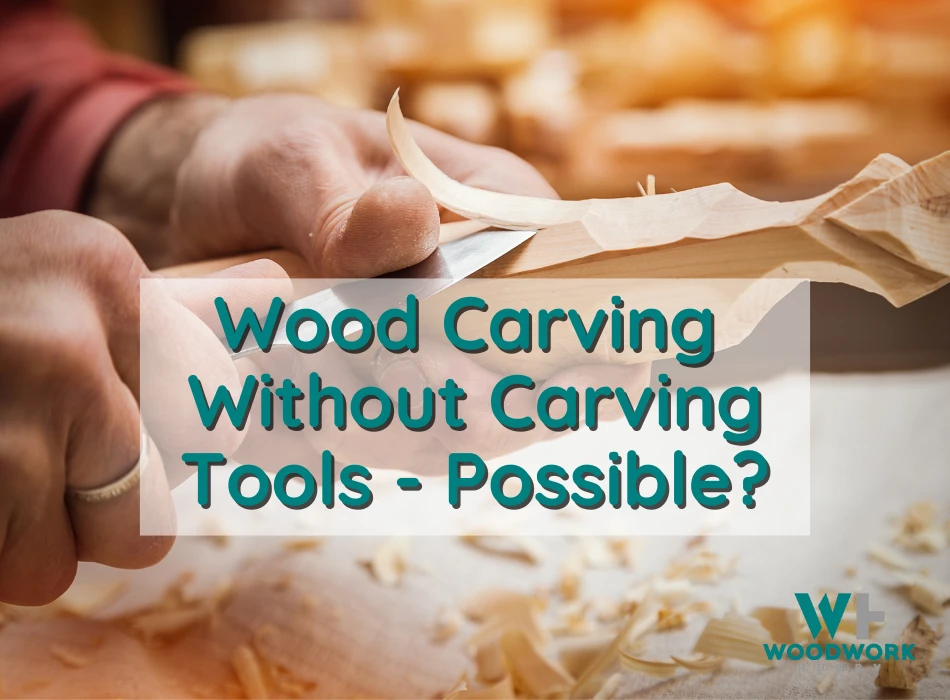Are you challenged by the desire to carve wood but hindered by a lack of traditional tools? I too have found myself in this situation, but after extensive research and hands-on experience, I’ve discovered that it’s entirely possible!
This blog post will guide you through the ingenious ways you can substitute everyday items as creative carving tools and skills to carve wood effectively without any specialized tools.
Key Takeaways
- Carving wood without traditional tools is possible by using alternative options such as an Exacto knife, a Swiss pocket knife, or creating homemade carving tools.
- Choosing the right type of wood and understanding basic carving techniques are essential for successful tool-less wood carving.
- Safety should always be a top priority when working with homemade carving tools. Remember to wear protective gloves and safety glasses, secure your work surface, carve away from your body, and keep your tools sharp.
When I started carving, I would use these basic tools before buying the traditional carving tools.
Understanding the Basics of Wood Carving
To successfully carve wood without traditional tools, it’s important to first understand the basics of wood carving.
Choosing the right wood
Choosing the right wood plays a pivotal role in successful carving, especially when you’re trying to do it without traditional tools. Softwoods are usually easier to carve; basswood, white pine, and butternut are some of your best options here.
Their soft, even grain allows for smooth cuts, making them ideal choices even if you’re just using an improvised knife or homemade whittling tools. However, if you prefer harder woods like oak or maple due to their durability and richer color patterns that add depth to carvings – remember they might demand more time and effort.
The beauty of cherry, black walnut, or mahogany cannot be overstated either! But always make sure your chosen piece of wood is free from imperfections like knots and cracks which could potentially mar your masterpiece.
Basic techniques of wood carving
Carving wood may seem like a craft reserved for professionals, but with a bit of knowledge about basic techniques, it becomes an accessible hobby for everyone. First and foremost is selecting the right type of wood; softwoods such as cedar and basswood are ideal for beginners while hardwoods like oak or maple require more skill and sharper tools.
The artistry begins by sketching your design directly on the selected piece of wood. Don’t rush this step—having a clear plan will make carving much easier later on. Afterward comes cutting into your marked lines using either a carving knife or one you’ve made yourself using materials like high-quality razor blades or transformed Swiss knives.
As you progress in experience, explore more complex techniques such as relief carving where you carve figures onto flat surfaces, Intaglio – engraving images into surfaces, chip carving which involves chipping out pieces from the surface to create patterns or “in-the-round” carvings that need attention from all angles.
Lastly, never forget to finish your work by sanding it smooth and applying finishes like paste wax, Danish oil or spray urethane to protect and highlight its beauty.
How to Carve Wood Without Traditional Tools
Carving wood without traditional tools is possible by utilizing alternative options such as an Exacto knife, a Swiss pocket knife, or even creating homemade carving tools.
Using an Exacto Knife
Harnessing the versatility of an Exacto knife, I’ve discovered it to be a handy tool in my wood carving endeavors. This compact cutting instrument, often found among standard crafting tools or even in school supply kits, can take on wood carving tasks without difficulty.
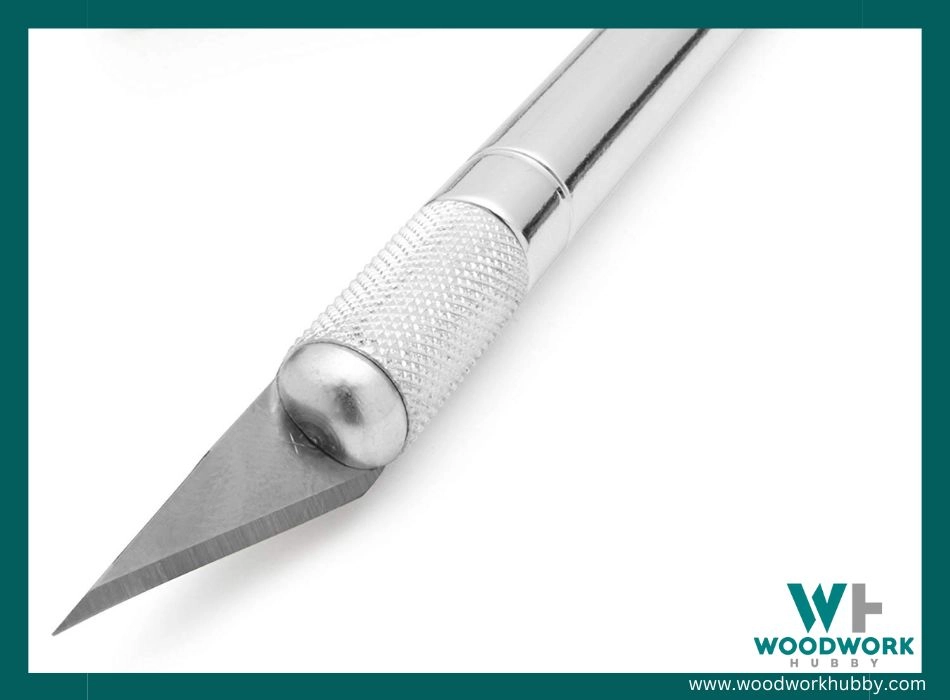
The key lies in its sharp and easily replaceable blades that make detailed cuts with precision – an essential quality for intricate aspects of your design.
Despite its size, don’t underestimate this little powerhouse because when used correctly, the Exacto knife delivers results comparable to professional-grade wood carving knives like BeaverCraft Cutting Knife C2.
Utilizing a Swiss pocket knife
One of the most versatile tools for carving wood without traditional tools is a Swiss pocket knife. With its compact size and multiple functions, a Swiss pocket knife can be an excellent alternative for those who don’t have access to specialized carving tools.
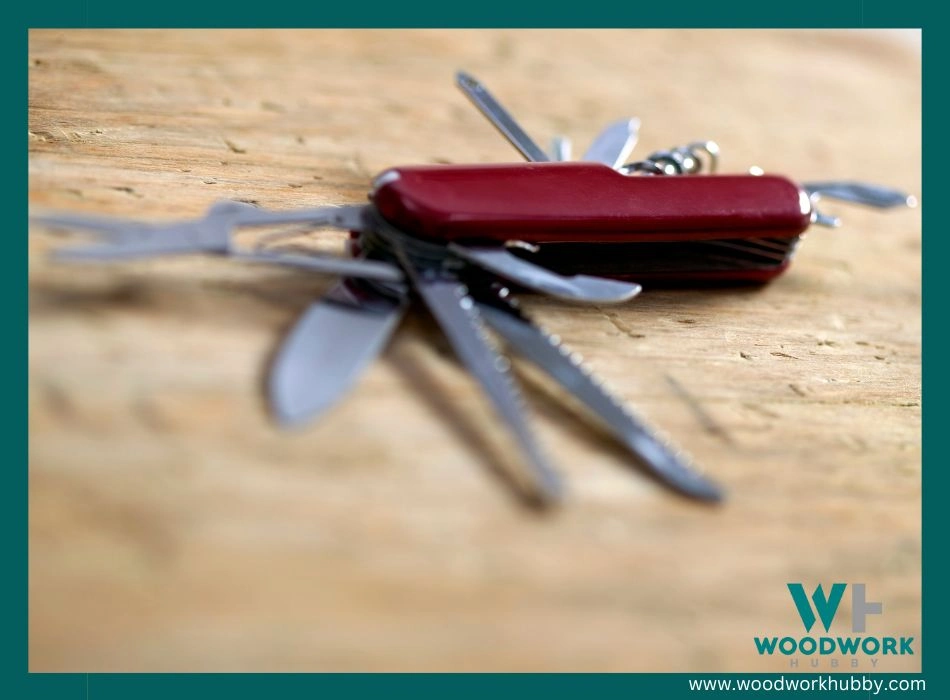
The sharp blade of the Swiss knife allows you to make precise cuts and intricate designs on wood. Additionally, some models come with saw blades that can cut through softwoods easily.
By using different features of a Swiss pocket knife creatively, you can embark on various woodcarving projects with ease. So, whether you’re whittling small figurines or creating detailed patterns on wooden surfaces, a Swiss pocket knife is definitely worth considering as your go-to tool for carving wood without the need for traditional equipment.
Creating homemade carving tools
Creating homemade carving tools is a great way to customize your wood carving experience and save money. With a few simple materials and some creativity, you can make your own tools that work just as effectively as commercially available options.
Don’t let wood carving be expensive. I created this article to show you what it costs.
Here are some ideas for creating homemade carving tools:
- Mallet: To create a mallet, you’ll need a hardwood like oak or maple for the head and a sturdy handle. Cut the wood into the desired shape for the head and secure it to the handle using glue or screws. A galvanized pipe can also be used as a mallet head.
- Chisels: Chisels are essential tools for wood carving. You can make your own by starting with a high-quality razor blade or utility knife blade. Attach the blade to an oakwood dowel using epoxy or strong adhesive, ensuring that it is securely fixed in place.
- Gouges: Gouges are curved chisels used for creating hollows and curves in wood carvings. To make your own gouge, start with a sturdy piece of steel like a 1095 steel blade. Shape the steel into the desired gouge profile using heat and shaping techniques commonly used in blacksmithing.
- Sharpening Tools: Keeping your carving tools sharp is crucial for achieving clean and precise cuts. You can make your own sharpening tools by using an abrasive belt on a grinder or making sharpening blocks from high-quality stones.
Steps to Carving Wood Without Tools
To carve wood without traditional tools, follow these steps: prepare the wood by selecting a suitable piece and securing it in place, make the initial cuts using an Exacto knife or Swiss pocket knife, and refine your carving by slowly removing excess material with precise movements.
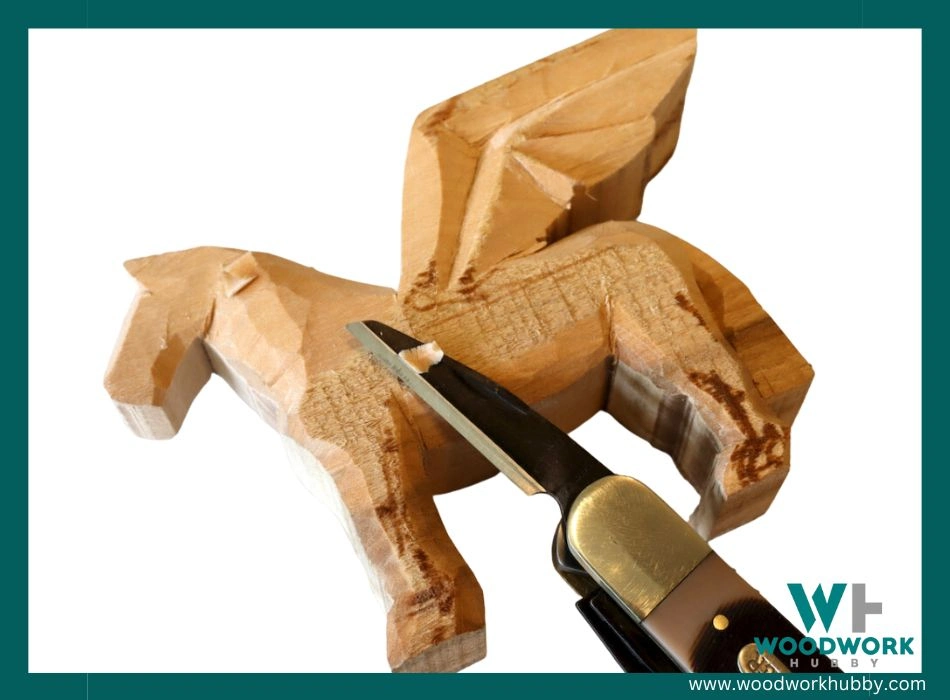
Finally, finish your carving by sanding it for a smooth and polished look.
Preparing the wood
To start carving wood without tools, it is essential to properly prepare the wood. Begin by selecting a suitable piece of hardwood like oak or maple, as these woods are ideal for intricate carvings.
Softwoods like cedar and basswood can also be used for simpler projects. Before you begin carving, make sure the wood is clean and free from any dirt or debris. Additionally, if the wood has been freshly cut, allow it to dry thoroughly to prevent warping or cracking during the carving process.
By taking these steps in preparing the wood, you can ensure a smoother and more enjoyable carving experience.
Making the initial cuts
To start carving wood without tools, the first step is to make the initial cuts. This can be done using a variety of alternative methods such as an Exacto knife, a Swiss pocket knife, or even homemade carving tools.
Choose a sharp blade for clean and precise cuts. Begin by marking your design on the wood with a pencil or marker. Then carefully make small incisions along the lines, gradually deepening them as you go.
Take your time and work slowly to avoid any mistakes or accidents. Remember to always hold the blade securely and cut away from your body for safety purposes.
Refining and finishing your carving
Once you have made the initial cuts and shaped your wood carving, it’s time to refine and finish it. This is where attention to detail really comes into play. Start by using smaller tools such as U-gouges or V-gouges to remove any remaining rough areas or excess wood that may be interfering with the final design.
Take your time and work slowly, being careful not to accidentally remove too much material.
After refining the shape, it’s important to sand the surface of your carving for a smooth finish. Begin with coarse-grit sandpaper (around 120-180) to remove any tool marks or inconsistencies in the wood grain.
Gradually move up to finer grits (such as 220-320) for a polished result.
Remember, always sand along the grain of the wood and use light pressure. It can be helpful to wet your carving before sanding as this will raise any loose fibers in preparation for smoothing them out.
Safety Tips for Wood Carving without Tools
Wood carving without traditional tools can still pose some safety risks. Here are some important safety tips to keep in mind:
- Wear protective gloves and safety glasses to protect your hands and eyes from wood chips and potential injuries.
- Make sure you have a stable work surface or bench to carve on, ensuring that it won’t slip or move while you’re working.
- Be aware of the direction of the wood grain when carving, as this can affect the stability and strength of the wood and impact your carving technique.
- Avoid carving near your body or any body parts, always carving away from yourself to prevent accidental injuries.
- Take breaks regularly to rest your hands and avoid overexertion, as wood carving can be physically demanding.
- Keep your tools sharp, as dull tools can slip and cause accidents. Regularly sharpen or replace blades as needed.
This is what I found out about how long wood carving takes.
Making Your Own Carving Tools
In this section, we will explore how you can make your own carving tools using everyday objects.
Materials needed
To make your own wood carving tools, you’ll need a few basic materials. One option is to create a mallet, which requires a sturdy piece of hardwood like oak or maple for the head and an oakwood dowel for the handle.
Another useful tool is a gouge, where you can repurpose a galvanized pipe by sharpening one end into a V-notch. For making your own high-quality razor into a whittling knife, you’ll need a 1095 steel blade, as well as an abrasive belt and either a sharpening stone or grinder to shape and sharpen the blade.
Lastly, if you want to convert a regular butter knife into a wood-carving tool, all you need is sandpaper or abrasive material to grind off the dull edge and smooth out any serration on the blade.
Procedure for making a mallet
I’ll walk you through the simple procedure for making a mallet, which is an essential tool when it comes to wood carving without traditional tools. To begin, gather the necessary materials – an oakwood dowel and a galvanized pipe.
Cut the dowel into two equal pieces of about 9 inches each. These will serve as the handle and head of your mallet.
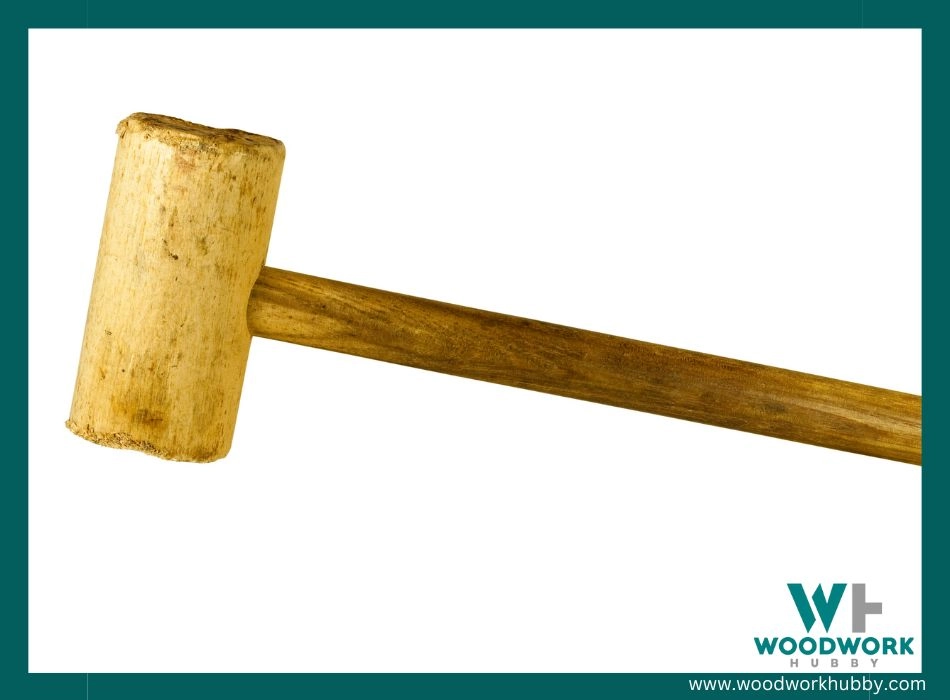
Next, drill a hole in one end of both dowel pieces that is slightly larger than the diameter of your galvanized pipe. Insert one end of the pipe into each hole until they are firmly secured in place.
Now, it’s time to assemble your mallet. Position one dowel piece vertically on a solid surface with its newly attached pipe facing upwards. Carefully slide the other dowel piece over this upward-facing pipe until it rests horizontally on top.
Frequently Asked Questions
What are some alternative materials that can be used to carve wood if traditional tools are not available?
What can be used to carve wood if no tools are available?
If you find yourself wanting to carve wood but don’t have any traditional tools on hand, there are still a few alternatives you can consider. One option is to use the sharp edge of an exacto knife, which can help you make smaller cuts and intricate designs.
Another alternative is utilizing a Swiss pocket knife, which often comes with various blades that can be used for carving purposes. Additionally, if you’re feeling crafty, you can create your own homemade carving tools using materials like galvanized pipes or oakwood dowels.
So even without traditional tools, there are creative ways to embark on your wood carving journey.
Is any knife suitable for wood carving?
When it comes to wood carving, not just any knife will do. While some knives may seem like they could work for carving, using the wrong knife can lead to frustration and potential injury.
It is important to use a knife specifically designed for wood carving, such as a whittling or carving knife. These knives have sharp blades and are specifically shaped and balanced for precision cutting into wood.
They allow you to achieve the desired depth and detail without compromising safety or control. So when it comes to wood carving, make sure you invest in a proper wood carving knife rather than attempting to use any random knife you may have on hand.
What’s the easiest thing to carve out of wood?
When starting out with wood carving without tools, it’s important to choose a beginner-friendly project. The easiest thing to carve out of wood is a bar of soap. Soap is soft and easy to work with, making it an ideal material for beginners, especially kids who are just getting started with wood carving.
Carving soap allows you to practice basic techniques like shaping and refining your cuts while working on a smaller scale. It’s a fun and low-cost way to explore the art of wood carving without needing any specialized tools or expensive materials.
Plus, once you’ve mastered carving soap, you’ll be better equipped and more confident in tackling larger projects using traditional woodcarving tools.
Conclusion – How To Carve Without Tools
In conclusion, while traditional wood carving tools may be the ideal choice for professional and intricate projects, there are alternative methods to carve wood without tools. By using homemade whittling tools or repurposing everyday objects like knives and drills with specialized bits, you can still enjoy the art of wood carving.
Just remember to prioritize safety and choose the appropriate materials for each carving technique. So go ahead and unleash your creativity – even without traditional tools, you can create beautiful wooden masterpieces!
FAQs
1. Is it possible to carve wood without using any tools?
While traditional wood carving typically involves the use of specialized tools, there are alternative methods such as sanding and shaping with abrasive materials that can achieve similar results without traditional carving tools.
2. What materials can be used for wood carving without tools?
Materials such as sandpaper, files, rasps, and even household items like knives or spoons can be utilized for wood carving without traditional carving tools. These materials can help shape and smooth the wood to create desired designs.
3. Are there any techniques that can be used to carve wood without tools?
Yes, there are various techniques that can be employed when carving wood without traditional tools. These include sanding in specific motions, scraping with a sharp edge or corner of a tool-like object, or using repetitive friction-based movements to gradually remove layers of material.
4. What are some beginner-friendly projects for carving wood without tools?
For beginners interested in trying their hand at woodcarving without conventional tools, simple projects like making small figurines or decorative ornaments from softwoods like pine or basswood provide a great starting point. These projects allow you to practice basic techniques while creating something visually appealing and satisfying.

